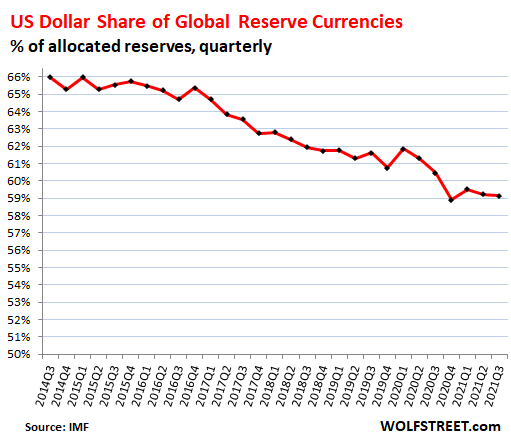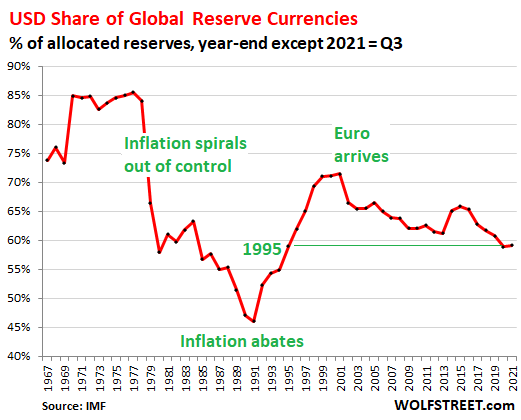US Dollar’s Status as Dominant “Global Reserve Currency” at 25-Year Low. And USD Exchange Rates?
Euro’s 20th birthday after dreams of “Dollar Parity” put on ice during Euro Debt Crisis. Central banks still leery of Chinese renminbi.
The global share of US-dollar-denominated exchange reserves declined to 59.15% in the third quarter, from 59.23% in the second quarter, hobbling along a 26-year low for the past four quarters, according to the IMF’s COFER data released today. Dollar-denominated foreign exchange reserves are Treasury securities, US corporate bonds, US mortgage-backed securities, and other USD-denominated assets that are held by foreign central banks.

In 2001 – the moment just before the euro officially arrived as bank notes and coins – the dollar’s share was 71.5%. Since then, it has dropped by 12.3 percentage points.
In 1977, when inflation was raging in the US, the dollar’s share was 85%. And when it looked like the Fed wasn’t doing anything about inflation that was threatening to spiral out of control, foreign central banks began dumping USD-denominated assets, and the dollar’s share collapsed.
The plunge of the dollar’s share bottomed out in 1991, after the inflation crackdown in the early 1980s caused inflation to abate. As confidence grew that the Fed would keep inflation more or less under control, the dollar’s share then surged by 25 percentage points until 2000 when the euro arrived.
Since then, over those 20 years, other central banks have been gradually diversifying away from US dollar holdings (year-end data, except for 2021 = Q3):

Not included in global foreign exchange reserves are the assets held by a central bank in its own currency, such as the Fed’s holdings of dollar-denominated assets, the ECB’s holdings of euro-denominated assets, or the Bank of Japan’s holdings of yen-denominated assets.
Impact of exchange rates on exchange reserves.
…click on the above link to read the rest of the article…